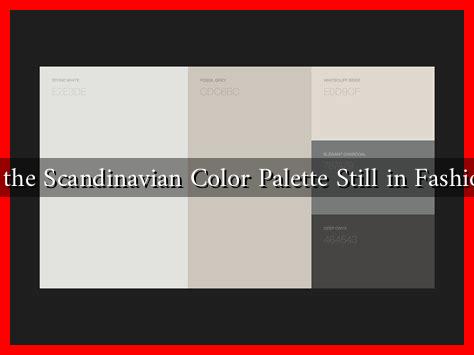-
Table of Contents
Is the Scandinavian Color Palette Still in Fashion?
The Scandinavian color palette, characterized by its muted tones, natural hues, and minimalist aesthetic, has been a dominant trend in interior design and fashion for several years. As we move further into the 2020s, the question arises: Is this beloved palette still in vogue? This article explores the enduring appeal of the Scandinavian color palette, its evolution, and its relevance in contemporary design.
The Essence of the Scandinavian Color Palette
The Scandinavian color palette typically features a range of soft, neutral colors, including whites, grays, beiges, and pastels. These colors are often inspired by the natural landscapes of the Nordic countries, promoting a sense of calm and tranquility. Key characteristics include:
- Neutral Tones: Whites and grays dominate, creating a clean and airy feel.
- Natural Elements: Earthy tones like browns and greens reflect the surrounding nature.
- Pastel Accents: Soft blues, pinks, and yellows add subtle pops of color without overwhelming the space.
This palette is not just about color; it embodies a lifestyle that values simplicity, functionality, and sustainability—principles that resonate deeply in today’s design ethos.
The Evolution of Scandinavian Design
Scandinavian design has evolved significantly since its inception in the mid-20th century. Initially celebrated for its functionality and simplicity, it has now integrated more diverse influences while maintaining its core principles. Recent trends have seen the incorporation of:
- Bold Accents: While the base remains neutral, designers are increasingly using bold colors as accents to create focal points.
- Textural Variety: Mixing materials like wood, metal, and textiles adds depth and interest to the minimalist aesthetic.
- Personalization: Homeowners are encouraged to infuse their personalities into spaces, leading to a more eclectic interpretation of Scandinavian design.
These adaptations suggest that while the traditional Scandinavian palette remains relevant, it is evolving to meet contemporary tastes and preferences.
Current Trends and Statistics
According to a recent survey by the National Kitchen and Bath Association, 60% of homeowners still prefer neutral color schemes for their interiors, with Scandinavian-inspired palettes leading the way. Additionally, a report from Pinterest revealed that searches for “Scandinavian decor” increased by 45% in 2023, indicating a sustained interest in this design style.
Moreover, the rise of sustainable living has further solidified the Scandinavian aesthetic’s relevance. As consumers become more environmentally conscious, the emphasis on natural materials and eco-friendly practices aligns perfectly with the Scandinavian ethos. Brands like IKEA continue to innovate with sustainable products that reflect this palette, ensuring its place in modern homes.
Case Studies: Brands Embracing the Scandinavian Palette
Several brands have successfully integrated the Scandinavian color palette into their offerings, showcasing its versatility and timelessness:
- IKEA: Known for its minimalist designs, IKEA frequently updates its collections to include soft hues and natural materials, appealing to a broad audience.
- Muuto: This Danish design brand emphasizes modern interpretations of classic Scandinavian design, often using muted colors paired with bold shapes.
- HAY: HAY’s furniture and home accessories reflect a contemporary take on the Scandinavian palette, incorporating playful colors while maintaining a minimalist approach.
These brands demonstrate that the Scandinavian color palette is not only enduring but also adaptable to changing consumer preferences.
Conclusion: The Future of the Scandinavian Color Palette
In conclusion, the Scandinavian color palette remains a significant trend in both interior design and fashion. Its emphasis on simplicity, functionality, and sustainability resonates with modern consumers seeking calm and cohesive spaces. While the palette is evolving to include bolder accents and diverse textures, its core principles continue to thrive. As we look to the future, it is clear that the Scandinavian color palette will remain a staple in design, reflecting both timeless elegance and contemporary innovation.
For more insights on Scandinavian design trends, you can visit Scandinavian Design.


